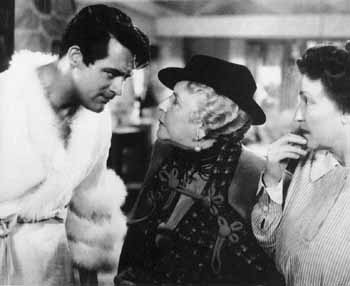|
In a thoroughly screwball manner, Susan manages to thoroughly control the story's action. Despite David's best attempts to meet with Mr. Peabody or Miss Swann, Susan keeps managing to divert him. Insisting that she "needs" his help with her pet leopard "Baby," she gets him to her family farm in Connecticut. At this point, Susan's active desire is fully revealed, as is David's body as an object of desire. He is seen without his shirt peeking through the shower door (rather risqué for the period). When he finds his clothes are gone, he parades around in a flowing women's robe, answering the door for Susan's aunt, and jumping into the air. He then puts on a skin-tight riding costume, before Susan relents and finds "clothes" for him. She repeatedly calls attention to how much more handsome he is without his glasses; this entire sequence focuses attention on David's body (Susan manages to shower and change clothes without putting herself on display).

After Susan steals his clothes, David wears
a woman's robe in Bringing Up Baby.
With her desire and intentions revealed ("I'm going to marry him!"), Susan continues to make David's life more and more complicated and his escape back to New York and Miss Swann impossible. His anger keeps him from admitting his desire, except for brief moments when she appears vulnerable--while the camera can gaze at David sympathetically and lovingly, it is hard for the spectator to know how to look at Susan. David saves Susan by forcing a dangerous circus leopard (not Baby) into a prison cell--and then he promptly faints. The faint is the only point during the madcap adventure when David actually gives up--though life is thoroughly out of his control, he keeps up the good fight. The anti-hero must not lapse for long into the passive position, but remain an active participant in the heroine's adventures.
But as mentioned before, the screwball heroine generally ends with the upper hand. To win David for certain, Susan must keep pursuing him. After the dust has fallen from David's lost donation, dinosaur bone and fiancée, Susan finds David at the museum with the brontosaurus skeleton. Though he scrambles up a platform to avoid her, she climbs a ladder to talk to him, presenting him with the lost bone and the million dollars. As she laments that he hates her (and her ladder begins to wobble) David admits that he loves her--a moment that is interrupted by Susan's falling ladder and then the crumbling skeleton. David "saves" Susan, but she immediately takes over with her chattering--"Oh, David. Forgive me. You can. You still love me. You do."--wrapping up the film's narrative. While he incoherently mutters, "I . . . I . . . Susan . . . I . . . Oh, dear," submitting, as in the opening scene, to a woman--but this time to a woman who desires him. While in Teresa de Lauretis' discussion of patriarchal narrative the heroine waits at the end of the hero's journey, the screwball heroine must journey to claim her man. And though Susan's face is obscured throughout this scene by a veil, the dinosaur, or David's shoulder, the beauty of David (no glasses, though back at the museum) remains available to the camera and spectator.
page 5 of 6
 
|




